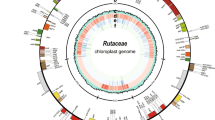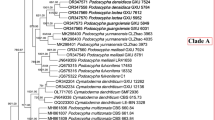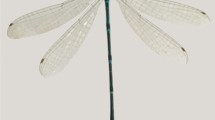Abstract
Pandanus odorifer (Forssk.) Kuntze commonly called as Kewda (Pandanaceae) is an important aromatic plant, most celebrated for its unique fragrance and the only native species representing subgenus Pandanus in India. In this study, chloroplast genome sequence of P. odorifer was sequenced for the first time and compared with the closely allied Pandanus species P. tectorius as well as other Pandanales members to understand gene content and structural variations. The size of complete plastome was 1,57,885 bp, with Large Single Copy (85,947 bp), Small Single Copy (18,112 bp) and a pair of Inverted Repeats, IRs (26,913 bp). The plastome exhibited total 133 genes, 82 protein coding genes and 19 genes duplicated in IR region. The multiple sequence alignment of all Pandanales plastomes exhibited conserved nature. The plastome of P. odorifer also showed truncated rps19, full length rpoC2 and unique RNA editing site which differentiated it from the closely allied P. tectorius plastome. The highest nucleotide diversity was found in ndhF and ycf4-cemA regions of P. odorifer and P. tectorius. The plastome of Pandanus exhibited conserved nature when compared to Pandanales plastomes, except an inversion leading to cemA-petA regions in Stemona plastomes. The phylogenetic analysis based on complete plastome and protein coding genes placed P. odorifer and P. tectorius as sister species.










Similar content being viewed by others
References
Amiryousefi A, Hyvonen J, Poczai P (2018b) The chloroplast genome sequence of bittersweet (Solanum dulcamara): Plastid genome structure evolution in Solanaceae. PLoS ONE 13:e0196069. https://doi.org/10.1371/journal.pone.0196069
Amiryousefi A, Hyvonen J, Poczai P (2018a) IRscope: an online program to visualize the junction sites of chloroplast genomes. Bioinformatics 34:3030–3031. https://doi.org/10.1093/bioinformatics/bty220
Beier S, Thiel T, Munch T, Scholz U, Mascher M (2017) MISA-web: a web server for microsatellite prediction. Bioinformatics 33:2583–2585. https://doi.org/10.1093/bioinformatics/btx198
Bremer K, Janssen T (2006) Gondwanan origin of major monocot groups inferred from dispersal-vicariance analysis. Aliso: A Journal of Systematic and Evolutionary Botany 22(1):22–27
Buerki S, Callmander MW, Devey DS, Chappell L, Gallaher T, Munzinger J, Haevermans T, Forest F (2012) Straightening out the screwpines: A first step in understanding phylogenetic relationships within Pandanaceae. Taxon 61(5):1010–1020. https://doi.org/10.1002/tax.615008
Callmander MW, Wohlhauser S, Laivao MO (2001) Une nouvelle section du genre Pandanus (Pandanaceae) à Madagascar: Pandanus sect. Tridentistigma Adansonia 23(1):49–57
Callmander MW, Chassot P, Küpfer P, Lowry II, PP (2003) Recognition of Martellidendron, a new genus of Pandanaceae, and its biogeographic implications. Taxon 52:747–762. https://doi.org/10.2307/3647349
Callmander MW, Booth TJ, Beentje H, Buerki S (2013) Update on the systematics of Benstonea (Pandanaceae): When a visionary taxonomist foresees phylogenetic relationships. Phytotaxa 112:57–60. https://doi.org/10.11646/phytotaxa.112.2.4
Callmander MW, Lowry PP, Forest F, Devey DS, Beentje H, Buerki S (2012) Benstonea Callm. & Buerki (Pandanaceae): characterization, circumscription, and distribution of a new genus of screw-pines, with a synopsis of accepted species. Candollea 67:323–345. https://doi.org/10.15553/c2012v672a12
Chase MW, Christenhusz M, Fay M, Byng J, Judd WS, Soltis D, Mabberley D, Sennikov A, Soltis PS, Stevens PF (2016) An update of the Angiosperm Phylogeny Group classification for the orders and families of flowering plants: APG IV. Bot J Linn Soc 181:1–20. https://doi.org/10.1111/boj.12385
Cummings MP, King LM, Kellogg EA (1994) Slipped-strand mispairing in a plastid gene: rpoC2 in grasses (Poaceae). Mol Biol Evol 11:1–8. https://doi.org/10.1093/oxfordjournals.molbev.a040084
Daniell H, Lin CS, Yu M, Chang WJ (2016) Chloroplast genomes: diversity, evolution, and applications in genetic engineering. Genome Biol 17(1):134. https://doi.org/10.1186/s13059-016-1004-2
Do HDK, Kim C, Chase MW, Kim JH (2020) Implications of plastome evolution in the true lilies (monocot order Liliales). Mol Phylogenet Evol 148:106818. https://doi.org/10.1016/j.ympev.2020.106818
Gallaher T, Callmander MW, Buerki S, Keeley SC (2015) A long distance dispersal hypothesis for the Pandanaceae and the origins of the Pandanus tectorius complex. Mol Phylogenet Evol 83:20–32. https://doi.org/10.1016/j.ympev.2014.11.002
Gallaher T, Callmander MW, Buerki S, Setsuko S, Keeley SC (2017) Navigating the ‘broad freeway’: ocean currents and inland isolation drive diversification in the Pandanus tectorius complex (Pandanaceae). J Biogeogr 44:1598–1611. https://doi.org/10.1111/jbi.12933
George B, Bhatt BS, Awasthi M, George B, Singh AK (2015) Comparative analysis of microsatellites in chloroplast genomes of lower and higher plants. Curr Genet 61:665–677. https://doi.org/10.1007/s00294-015-0495-9
Huynh KL (1975) La morphologie microscopique de la feuille et la taxonomie du genre Pandanus II. Le sous-genre Rykia. Bot Jahrb Syst 95:106–148
Huynh KL (1976) La morphologie microscopique de la feuille et la taxonomie du genre Pandanus III. Le sous-genre Lophostigma. Bot Jahrb Syst 97:72–119
Huynh KL (1977) La morphologie microscopique de la feuille et la taxonomie du genre Pandanus IV. Le sous-genre Kurzia. Bot Jahrb Syst 98:199–249
Huynh KL, KL H (1979) La morphologie microscopique de la feuille et la taxonomie du genre Pandanus. Vi: P. Subg. Vinsonia Et P. Subg. Martellidendron. 2: Considerations Sur P. Subg. Vinsonia
Jung J, Kim C, Kim JH (2021) Insights into phylogenetic relationships and genome evolution of subfamily Commelinoideae (Commelinaceae Mirb.) inferred from complete chloroplast genomes. BMC Genomics 22:231. https://doi.org/10.1186/s12864-021-07541-1
Katoh K, Standley DM (2013) MAFFT multiple sequence alignment software version 7: improvements in performance and usability. Mol Biol Evol 30:772–780. https://doi.org/10.1093/molbev/mst010
Kim Y, Shin J, Oh DR, Kim AY, Choi C (2020) Comparative Analysis of Complete Chloroplast Genome Sequences and Insertion-Deletion (Indel) Polymorphisms to Distinguish Five Vaccinium Species. Forests 11:927. https://doi.org/10.3390/f11090927
Kurtz S, Choudhuri JV, Ohlebusch E, Schleiermacher C, Stoye J, Giegerich R (2001) REPuter: the manifold applications of repeat analysis on a genomic scale. Nucleic Acids Res 29:4633–4642. https://doi.org/10.1093/nar/29.22.4633
Laivao MO, Callmander MW, Buerki S (2006) Sur les Pandanus (Pandanaceae) à stigmates saillants de la côte est de Madagascar. Adansonia 28:267–285
Lam VK, Soto Gomez M, Graham SW (2015) The Highly Reduced Plastome of Mycoheterotrophic Sciaphila (Triuridaceae) Is Colinear with Its Green Relatives and Is under Strong Purifying Selection. Genome Biol Evol 7:2220–2236. https://doi.org/10.1093/gbe/evv134
Lam VKY, Darby H, Merckx V, Lim G, Yukawa T, Neubig KM, Abbott JR, Beatty GE, Provan J, Soto Gomez M, Graham SW (2018) Phylogenomic inference in extremis: A case study with mycoheterotroph plastomes. Am J Bot 105:480–494. https://doi.org/10.1002/ajb2.1070
Liu J, Jiang M, Chen H, Liu Y, Liu C, Wu W (2021) Comparative genome analysis revealed gene inversions, boundary expansions and contractions, and gene loss in the Stemona sessilifolia (Miq.) Miq. chloroplast genome. PLoS One 16:e0247736. https://doi.org/10.1371/journal.pone.0247736
Lohse M, Drechsel O, Kahlau S, Bock R (2013) OrganellarGenomeDRAW–a suite of tools for generating physical maps of plastid and mitochondrial genomes and visualizing expression data sets. Nucleic Acids Res 41:W575–581. https://doi.org/10.1093/nar/gkt289
Lu Q, Ye W, Lu R, Xu W, Qiu Y (2018) Phylogenomic and Comparative Analyses of Complete Plastomes of Croomia and Stemona (Stemonaceae). Int J Mol Sci 19:2383. https://doi.org/10.3390/ijms19082383
Ma Q, Wang Y, Zhu L, Bi C, Li S, Li S, Wen J, Yan K, Li Q (2019) Characterization of the Complete Chloroplast Genome of Acer truncatum Bunge (Sapindales: Aceraceae): A New Woody Oil Tree Species Producing Nervonic Acid. Biomed Res Int 2019:7417239. https://doi.org/10.1155/2019/7417239
Mohsin HF, Wahab AI, Naz H, Shah ASA, Weber JFF (2008) Pandanaceae research in support for Industrial Plantation
Mower JP (2009) The PREP suite: predictive RNA editors for plant mitochondrial genes, chloroplast genes and user-defined alignments. Nucleic Acids Res 37:W253–W259. https://doi.org/10.1093/nar/gkp337
Nadaf AB, Zanan RL, Wakte KV (2011) A new endemic species of Pandanaceae from India: Pandanus palakkadensis. Kew Bull 66:183–186. https://doi.org/10.1007/s12225-011-9265-0
Nadaf A, Zanan R, Callmander MWX (2012) Indian Pandanaceae-an overview. Springer, New Delhi. https://doi.org/10.1007/978-81-322-0753-5
Nguyen LT, Schmidt HA, Von Haeseler A, Minh BQ (2015) IQ-TREE: a fast and effective stochastic algorithm for estimating maximum-likelihood phylogenies. Mol Biol Evol 32:268–274. https://doi.org/10.1093/molbev/msu300
Odintsova MS, Yurina NP (2006) Chloroplast genomics of land plants and algae. Biotechnological applications of photosynthetic proteins: biochips, biosensors and biodevices. Springer, Boston, MA, pp 57–72. https://doi.org/10.1007/978-0-387-36672-2_6
Park I, Yang S, Kim WJ, Song JH, Lee HS, Lee HO, Lee JH, Ahn SN, Moon BC (2019) Sequencing and comparative analysis of the chloroplast genome of Angelica polymorpha and the development of a novel indel marker for species identification. Molecules 24:1038. https://doi.org/10.3390/molecules24061038
Patel RK, Jain M (2012) NGS QC Toolkit: a toolkit for quality control of next generation sequencing data. PLoS ONE 7:e30619. https://doi.org/10.1371/journal.pone.0030619
Powell W, Morgante M, McDevitt R, Vendramin G, Rafalski J (1995) Polymorphic simple sequence repeat regions in chloroplast genomes: applications to the population genetics of pines. Proc Nat Acad Sci 92:7759–7763. https://doi.org/10.1073/pnas.92.17.7759
Provan J, Powell W, Hollingsworth PM (2001) Chloroplast microsatellites: new tools for studies in plant ecology and evolution. Trends Ecol Evol 16:142–147. https://doi.org/10.1016/S0169-5347(00)02097-8
Qiao J, Cai M, Yan G, Wang N, Li F, Chen B, Gao G, Xu K, Li J, Wu X (2016) High-throughput multiplex cp DNA resequencing clarifies the genetic diversity and genetic relationships among Brassica napus, Brassica rapa and Brassica oleracea. Plant Biotechnol J 14:409–418. https://doi.org/10.1111/pbi.12395
Raina V, Kumar A, Srivastava S, Syamsundar K, Kahol A (2004) Essential oil composition of ‘kewda’ (Pandanus odoratissimus) from India. Flavour Fragr J 19:434–436. https://doi.org/10.1002/ffj.1331
Rambaut A (2018) FigTree v1. 4.4. Institute of Evolutionary Biology. University of Edinburgh, Edinburgh
Ravi V, Khurana J, Tyagi A, Khurana P (2008) An update on chloroplast genomes. Plant Syst Evol 271:101–122. https://doi.org/10.1007/s00606-007-0608-0
Rogalski M, do Nascimento Vieira L, Fraga HP, Guerra MP (2015) Plastid genomics in horticultural species: importance and applications for plant population genetics, evolution, and biotechnology. Front Plant Sci 6:586. https://doi.org/10.3389/fpls.2015.00586
Rozas J, Ferrer-Mata A, Sánchez-DelBarrio JC, Guirao-Rico S, Librado P, Ramos-Onsins SE, Sánchez-Gracia A (2017) DnaSP 6: DNA sequence polymorphism analysis of large data sets. Mol Biol Evol 34:3299–3302. https://doi.org/10.1093/molbev/msx248
Schattner P, Brooks AN, Lowe TM (2005) The tRNAscan-SE, snoscan and snoGPS web servers for the detection of tRNAs and snoRNAs. Nucleic Acids Res 33:W686–W689. https://doi.org/10.1093/nar/gki366
Schwartz S, Elnitski L, Li M, Weirauch M, Riemer C, Smit A, Program NCS, Green ED, Hardison RC, Miller W (2003) MultiPipMaker and supporting tools: Alignments and analysis of multiple genomic DNA sequences. Nucleic Acids Res 31:3518–3524. https://doi.org/10.1093/nar/gkg579
Shi L, Chen H, Jiang M, Wang L, Wu X, Huang L, Liu C (2019) CPGAVAS2, an integrated plastome sequence annotator and analyzer. Nucleic Acids Res 47:W65–W73. https://doi.org/10.1093/nar/gkz345
Sokołowska J, Fuchs H, Celiński K (2021) New insight into taxonomy of European mountain pines, Pinus mugo complex, based on complete chloroplast genomes sequencing. Plants 10:1331. https://doi.org/10.3390/plants10071331
Soto Gomez M, Lin Q, da Silva Leal E, Gallaher TJ, Scherberich D, Mennes CB, Smith SY, Graham SW (2020) A bi-organellar phylogenomic study of Pandanales: inference of higher‐order relationships and unusual rate‐variation patterns. Cladistics 36:481–504. https://doi.org/10.1111/cla.12417
Stone BC (1976) The Pandanaceae of the New Hebrides, with an essay on intraspecific variation in Pandanus tectorius. Kew Bull 31:47–70. https://www.jstor.org/stable/4108995
Stone BC, BC S (1974) Towards An Improved Infrageneric Classification in Pandamus (Pandanaceae). Bot Jahrbücher für Systematik 94:459–540
Tan XH, Wang JH, Zhao KK, Zhu ZX, Wang HF (2019) Complete plastome sequence of Pandanus tectorius Parkinson ex Du Roi (Pandanaceae). Mitochondrial DNA Part B 4:68–69. https://doi.org/10.1080/23802359.2018.1536460
Thomson LA, Englberger L, Guarino L, Thaman R, Elevitch CR (2006) Pandanus tectorius (pandanus). Species profiles for Pacific Island agroforestry: 28
Tillich M, Lehwark P, Pellizzer T, Ulbricht-Jones ES, Fischer A, Bock R, Greiner S (2017) GeSeq–versatile and accurate annotation of organelle genomes. Nucleic Acids Res 45:W6–W11. https://doi.org/10.1093/nar/gkx391
Ulaszewski B, Jankowska-Wróblewska S, Świło K, Burczyk J (2021) Phylogeny of Maleae (Rosaceae) based on complete chloroplast genomes supports the distinction of Aria, Chamaemespilus and Torminalis as separate genera, different from Sorbus sp. Plants 10:2534. https://doi.org/10.3390/plants10112534
Wanga VO, Dong X, Oulo MA, Mkala EM, Yang JX, Onjalalaina GE, Gichua MK, Kirika PM, Gituru RW, Hu GW, Wang QF (2021) Complete Chloroplast Genomes of Acanthochlamys bracteata (China) and Xerophyta (Africa) (Velloziaceae): Comparative Genomics and Phylogenomic Placement. Front Plant Sci 12:691833. https://doi.org/10.3389/fpls.2021.691833
Wheeler GL, Dorman HE, Buchanan A, Challagundla L, Wallace LE (2014) A review of the prevalence, utility, and caveats of using chloroplast simple sequence repeats for studies of plant biology. Appl Plant Sci 2:1400059. https://doi.org/10.3732/apps.1400059
Wick RR, Schultz MB, Zobel J, Holt KE (2015) Bandage: interactive visualization of de novo genome assemblies. Bioinformatics 31:3350–3352. https://doi.org/10.1093/bioinformatics/btv383
Acknowledgements
Authors are grateful to the Savitribai Phule Pune University for providing funding and necessary support. AMD is thankful to SPPU-PDF [SPPU-PDF/ST/BL/2021/0001] for the fellowship support.
Author information
Authors and Affiliations
Corresponding authors
Ethics declarations
Disclosure of potential conflicts of interest
Authors declare no conflict of interest.
Research involving Human Participants and/or Animals
Not Applicable.
Informed consent
Not Applicable.
Statements and Declarations
This work was supported by Internal Quality Assurance Cell (IQAC), Savitribai Phule Pune University under scheme ASPIRE Research Mentorship Grant (18TEC000030).
Additional information
Publisher’s Note
Springer Nature remains neutral with regard to jurisdictional claims in published maps and institutional affiliations.
Electronic supplementary material
Below is the link to the electronic supplementary material.
Rights and permissions
About this article
Cite this article
Darshetkar, A.M., Patil, S.S., Pable, A.A. et al. Chloroplast genome sequence of Pandanus odorifer (Forssk.) Kuntze: genome features, mutational hotspots and phylogenetic analyses. Biologia 77, 3397–3412 (2022). https://doi.org/10.1007/s11756-022-01155-y
Received:
Accepted:
Published:
Issue Date:
DOI: https://doi.org/10.1007/s11756-022-01155-y




